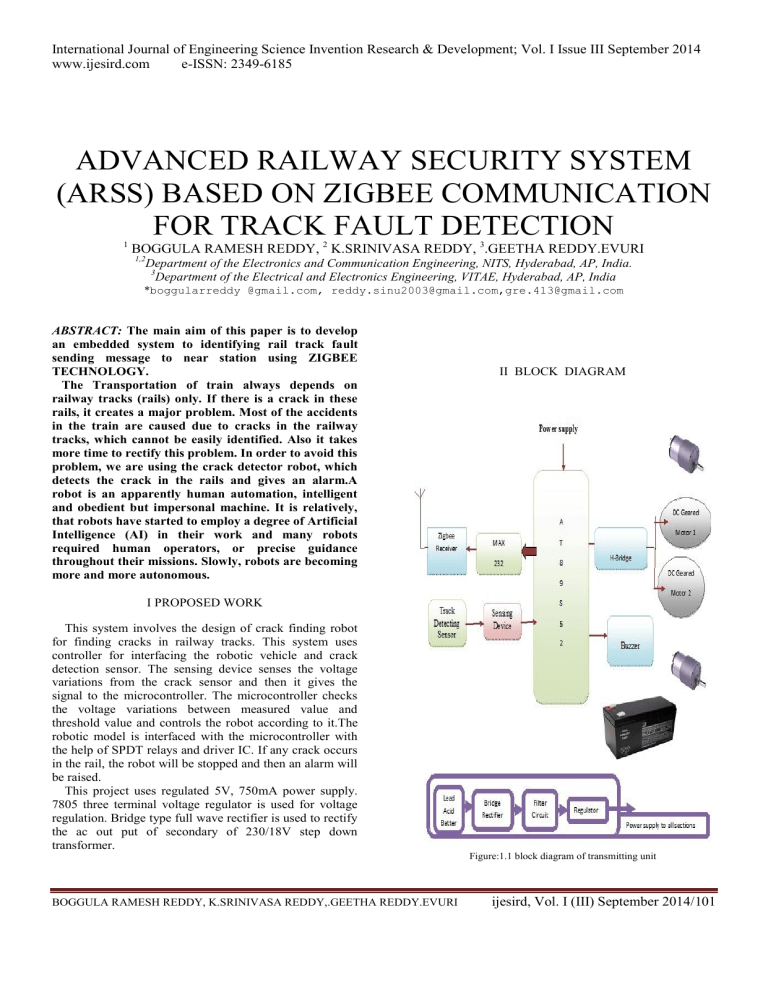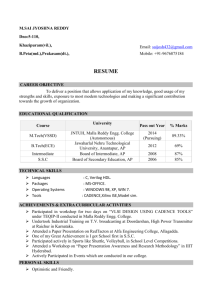advanced railway security system (arss) based on

International Journal of Engineering Science Invention Research & Development; Vol. I Issue III September 2014 www.ijesird.com e-ISSN: 2349-6185
ADVANCED RAILWAY SECURITY SYSTEM
(ARSS) BASED ON ZIGBEE COMMUNICATION
FOR TRACK FAULT DETECTION
1
BOGGULA RAMESH REDDY,
2
K.SRINIVASA REDDY,
3
.GEETHA REDDY.EVURI
1,2
Department of the Electronics and Communication Engineering, NITS, Hyderabad, AP, India.
3
Department of the Electrical and Electronics Engineering, VITAE, Hyderabad, AP, India
* boggularreddy @gmail.com, reddy.sinu2003@gmail.com,gre.413@gmail.com
ABSTRACT: The main aim of this paper is to develop an embedded system to identifying rail track fault sending message to near station using ZIGBEE
TECHNOLOGY.
The Transportation of train always depends on railway tracks (rails) only. If there is a crack in these rails, it creates a major problem. Most of the accidents in the train are caused due to cracks in the railway tracks, which cannot be easily identified. Also it takes more time to rectify this problem. In order to avoid this problem, we are using the crack detector robot, which detects the crack in the rails and gives an alarm.A robot is an apparently human automation, intelligent and obedient but impersonal machine. It is relatively, that robots have started to employ a degree of Artificial
Intelligence (AI) in their work and many robots required human operators, or precise guidance throughout their missions. Slowly, robots are becoming more and more autonomous.
II BLOCK DIAGRAM
I PROPOSED WORK
This system involves the design of crack finding robot for finding cracks in railway tracks. This system uses controller for interfacing the robotic vehicle and crack detection sensor. The sensing device senses the voltage variations from the crack sensor and then it gives the signal to the microcontroller. The microcontroller checks the voltage variations between measured value and threshold value and controls the robot according to it.The robotic model is interfaced with the microcontroller with the help of SPDT relays and driver IC. If any crack occurs in the rail, the robot will be stopped and then an alarm will be raised.
This project uses regulated 5V, 750mA power supply.
7805 three terminal voltage regulator is used for voltage regulation. Bridge type full wave rectifier is used to rectify the ac out put of secondary of 230/18V step down transformer.
Figure:1.1 block diagram of transmitting unit
BOGGULA RAMESH REDDY, K.SRINIVASA REDDY,.GEETHA REDDY.EVURI
ijesird, Vol. I (III) September 2014/101
International Journal of Engineering Science Invention Research & Development; Vol. I Issue III September 2014 www.ijesird.com e-ISSN: 2349-6185
IV RESULTS
A Flowchart of transmitting section
START
IDENTIFY RAILWAY
TRACK FAULT USING IR
SENSORS
TRSNSMIT THAT
MESSAGE THROUGH
ZIGBEE
END
B Flowchart of receiving section
START
RECEVER RECEVE THE
MESSAGE THROUGH
ZIGBEE
III HARDWARE&SOFTWARE TOOLS
A Hardware tools :
Microcontroller unit
Crack detection sensor
Interfacing unit
Robot Mechanism
B Software tools :
Keil Compiler Embedded C
DISPLAY ON LCD AT
NEAR STATION
END
BOGGULA RAMESH REDDY, K.SRINIVASA REDDY,.GEETHA REDDY.EVURI
ijesird, Vol. I (III) September 2014/102
International Journal of Engineering Science Invention Research & Development; Vol. I Issue III September 2014 www.ijesird.com e-ISSN: 2349-6185
V PINNING INFORMATION OF TRANSMITTER
It reduces the man power
Crack detecting efficiency is high.
Accuracy is high.
A Design View
VI PINNING INFORMATION OF RECIEVER
VII APPLICATIONS
Can be used for Railway Department.
Can be used for industries.
Used in detecting applications.
VIII ADVANTAGES
IX CONCLUSION
Accidents occurring in railway transportation systems cost a large number of lives. Many people die and several others get physical and mentally injured. Accidents are the major causes for traumatic injuries. There is certain need of advanced and robust techniques that can not only prevent these accidents but also eradicate all possibilities of their occurrence .Here We Have Designed Advanced
Railway Track Fault Detection System with remote station messaging system using Zigbee Communication.
Developed an embedded system to identifying rail track
BOGGULA RAMESH REDDY, K.SRINIVASA REDDY,.GEETHA REDDY.EVURI
ijesird, Vol. I (III) September 2014/103
International Journal of Engineering Science Invention Research & Development; Vol. I Issue III September 2014 www.ijesird.com e-ISSN: 2349-6185 fault sending message to near station using ZIGBEE
TECHNOLOGY.
By using Wireless sensor networks techniques we also develop more and more reliable security systems applications, in which continuously monitors the railway track through the sensors and detect any abnormality in the track. The sensor nodes are equipped with sensors that can sense the vibration in the railway track due a coming train.
The geographical positioning sensors are placed on the trains. These sensors send the train’s geographic location.
The complete process is needed to be real time in nature and should meet the deadlines.
REFERENCES
X FUTURE SCOPE
[1]
V.Reddy, “
Deployment of an integrated model for assessment of operational risk in railway track ”, Master Thesis,
Queensland University of Technology School of Engineering
Systems, 2007.
[2] C. Esveld, “ Modern railway Track
”. Second Edition, MRT
Productions. 2001
[3] D.Hesse “ Rail inspection using ultrasonic surface waves ”
Thesis ,Imperial College of London,2007
[4] C. Campos-Castellanos, Y.Gharaibeh, P. Mudge *, V.
Kappatos, “
The application of long range ultrasonic testing
(LRUT) For examination of hard to access areas on railway tracks
”. IEEE Railway Condition Monitoring and Non-
Destructive Testing (RCM 2011) Nov 2011.
[5] M. Singh, S.Singh1,J.Jaiswal, J. Hempshall “ Autonomus rail track inspection using vision based system
” .IEEE
International Conference on Computational Intelligence for
Homeland Security and Personal Safety .October 2006. pp 56-
59
[6] S.Zheng, X.An, X.Chai, L. Li “ Railway track gauge inspection method based on computer vision
” IEEE
International Conference on Mechatronics and Automation,
2012. pp 1292-1296
[7] W. Al-Nuaimy , A. Eriksen and J. Gasgoyne “ Train-mounted gpr for high-speed rail trackbed inspection ” Tenth
International Conference on Ground Penetrating Radal; 21 -24
June, 2004
[8] A.Vanimiredd, D.A.Kumari “ Automatic broken track detection using LED-LDR assembly ” International Journal of
Engineering Trends and Technology (IJETT) - Volume4
Issue7- July 2013
[9] Hayre, Harbhajan S., " Automatic Railroad Track Inspection ,"
Industry Applications, IEEE Transactions on , vol.IA-10, no.3, pp.380,384, May 1974
[10] Z. Sam Daliri1, S. Shamshirband , M.A. Besheli “ Railway security through the use of wireless sensor networks based on fuzzy logic
”. International Journal of the Physical
SciencesVol. 6(3), pp. 448-458, 4 February, 2011
[11] S. Ramesh, S. Gobinathan “ Railway faults tolerance techniques using wireless sensor networks ”. IJECT Vol. 3,
Issue 1, Jan. - March 2012.
[12] A. Z Lorestani ,S. A Mousavi, R. Ebadaty, “ Monitoring
RailTraffic Using Wireless Sensor Network (WSN )” IJCSET
,June 2012, Vol 2, Issue 6,1280-1282
[13] Aboelela, E.Edberg, W.Papakonstantinou, C.Vokkarane, V,
" Wireless sensoer network based model for secure railway opeerations ," Performance, Computing, and Communications
Websites:
1.www.howstuffworks.com
2.www.answers.com
3.www.wikipedia.org
4.www.atmel.com
5.www.8051projects.com
6.Embedded systems with 8051 by kenith j ayala
7. Dr James Conrad http://www.coe.uncc.edu/~jmconrad
Accessed: March 2006
8. Philips Semiconductors http://www.semiconductors.philips.com
Accessed: March 2006
9. Philips Semiconductors http://www.semiconductors.philips.com/acrobat_download/literature/939
8/39340011.pdf
Accessed: March 2006
Authors:
Mr.
B.RAMESH REDDY pursuing M.Tech in
VLSI & ES from Nagole Institute of Tech.Sci.,Hyderabad. he completed B.Tech ECE from JNTUH affiliated engineering collegeMIST,SATHUPALLY.
Mr .K. Srinivasa Reddy is Associate Professor of the Electronics and Communication Engineering,
Nagole Institute of Technology and Science, Hyderabad
.He received his B.Tech degree in Electronics and
Communication Engineering from JNT University,
Hyderabad, and M.Tech degree in Embedded Systems from JNT University, Hyderabad.. He is a member of The
International Association of Engineers (IAENG). He had ten publications in National and International Journals. He has written three text books in the field of wireless communications.
Mrs .Evuri.Geetha Reddy is Assistant
Professor of the EEE, VITAE, Hyderabad .She received his B.Tech degree in EEE from JNT University,
Hyderabad, and M.Tech degree PED from Vignan
University,Guntur.. She is a member of The International
Association of Engineers.
BOGGULA RAMESH REDDY, K.SRINIVASA REDDY,.GEETHA REDDY.EVURI
ijesird, Vol. I (III) September 2014/104
